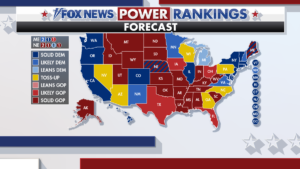2024 US Election Results Fox: Insights and Analysis

Overview of the 2024 US Election Results
The 2024 US elections have resulted in a dynamic shift in the political landscape, showcasing key races and pivotal outcomes that reflect the current sentiments of the electorate. Major races involved both incumbents and challengers, seeing some significant wins for the Democratic and Republican parties. With varying degrees of competitiveness across the country, voter turnout has shown to be a critical indicator of engagement and activism among different demographic groups.
In the presidential race, the candidates representing the two main parties were seen as polarizing figures. The incumbent president aimed to solidify their position against a well-known challenger, who garnered substantial support through grassroots movements and strategic campaigning. The election results illuminated the divide between urban and rural voters, highlighting how geographical differences influence political preferences. Although the incumbent party celebrated notable victories in key battleground states, a few unexpected losses emerged, shaking the confidence of many political analysts.
In congressional races, both the House of Representatives and the Senate experienced heightened contestation. With some state legislatures leaning more Democratic while others remained firmly in Republican hands, the balance of power shifted in several instances. The outcome of these races not only emphasized the prominence of issues such as healthcare, immigration, and climate change but also reflected voter concerns stemming from economic developments leading up to the election.
Overall voter turnout was reported to be higher than in previous elections, indicating a strong engagement from various sectors of the population. This engagement can be attributed to heightened political awareness, driven by the impacts of social media and advocacy groups mobilizing voters. As the dust settles on the 2024 elections, the insights drawn will undoubtedly contribute to shaping the political dialogue in the coming years, with focus on analyzing the implications of these results for future strategies by both parties.
Analysis of Voting Trends and Demographics
The 2024 US elections revealed significant shifts in voting trends and demographics compared to previous election cycles, highlighting how diverse age groups, ethnicities, and educational backgrounds influenced electoral outcomes. As the electorate evolves, it is essential to analyze how these demographic factors shaped voting behavior in various regions.
In recent elections, younger voters have emerged as a pivotal force, increasingly participating in the democratic process. This demographic, primarily composed of millennials and Generation Z, tends to prioritize issues such as climate change, social justice, and economic inequality. Their engagement was markedly higher in 2024, with many young voters mobilizing through social media campaigns and grassroots movements. This commitment to progressive causes aligns them closely with particular candidates and initiatives, underscoring the importance of addressing their concerns in political discourse.
Moreover, the changing landscape of ethnic and racial demographics has also influenced voting patterns significantly. The increasing diversity within the electorate has led to a more nuanced political climate. In the 2024 elections, voters from Hispanic, Black, and Asian backgrounds demonstrated distinct preferences based on their socio-economic realities and cultural values. Issues of immigration reform, systemic racism, and economic opportunities resonated deeply within these communities, showcasing their impact on electoral outcomes compared to past elections.
Education levels also played a crucial role in shaping voter preferences. Those with higher educational attainment, particularly college graduates, tended to gravitate towards candidates focused on progressive policies and climate action. In contrast, those with lower levels of education often prioritized economic stability and traditional values. This dichotomy underscores the complexity of the electorate and the necessity for candidates to connect with various voter segments on relevant issues.
Overall, the analysis of voting trends and demographics offers valuable insights into the evolving American electorate, reflecting a shift towards increased engagement from historically underrepresented groups, while also highlighting the influence of social issues and economic factors on voter decisions.

Key Takeaways for Political Parties
The 2024 US election results have provided a wealth of insights for political parties as they evaluate their strategies and effectiveness in engaging voters. Firstly, one of the key lessons from the election is the significance of appealing to diverse voter bases. Parties that successfully tailored their messages to resonate with various demographics, including younger voters, ethnic minorities, and suburban residents, tended to perform better at the polls. This strategic outreach can no longer be seen as supplementary; it is essential for securing broad-based support.
Furthermore, the data indicates that emphasis on specific issues can profoundly influence voter decisions. For example, parties that prioritized economic recovery, sustainability, and healthcare access were able to connect more effectively with constituents who viewed these issues as paramount. The ability to articulate clear, actionable solutions in these areas has proven critical for campaign success. In contrast, those who focused on divisive topics or failed to propose concrete plans struggled to inspire voter confidence, reflecting a potential misalignment with the electorate’s priorities.
Additionally, candidate authenticity emerged as a crucial factor. Politicians who communicated genuine personal narratives and demonstrated integrity were able to foster trust among voters. This human connection can create a significant advantage, especially when compared to candidates perceived as out of touch with the populace’s concerns. As parties analyze these outcomes, leadership will likely shift towards individuals adept at navigating these interpersonal dimensions of campaigning.
In light of the results, the effectiveness of digital campaigning also warrants attention. Engagement through social media and targeted online ads has reshaped the political landscape, enabling parties to reach and mobilize potential supporters effectively. However, the need for transparency in digital outreach has become increasingly apparent, as misinformation remains a critical threat to candidate integrity and voter trust.
Overall, the lessons drawn from the 2024 election will shape not only the immediate strategies of political parties but also their long-term priorities and policies in the lead-up to future elections.
Predictions and Speculations for Future Elections
The 2024 US election results are poised to significantly influence the broader political landscape of the country. As analysts sift through the outcomes, a variety of predictions and speculations regarding future elections are emerging. One potential implication is a shift in political power. Depending on the results and voter turnout, parties may find themselves reevaluating their strategies and outreach efforts to woo undecided voters and appeal to demographics that may have shifted during the 2024 campaign.
Political analysts suggest that current events are shaping a new narrative in the electoral arena, prompting parties to adapt their platforms accordingly. Emerging trends such as the growing importance of young voters and minority demographics could force traditional party lines to evolve. As the influence of social media continues to expand, candidates may increasingly harness these platforms for campaigning, thus altering the dynamics of voter engagement and information dissemination. Analysts believe that failure to adjust to these emerging trends could lead to detrimental consequences for established political entities.
Furthermore, speculation surrounding potential future candidates is already capturing the public’s attention. Names are being floated in both major parties, suggesting a possible shift towards more dynamic and relatable figures capable of resonating with a diverse electorate. Party strategies may increasingly focus on grassroots funding and digital campaigns to connect with voters more effectively. As issues such as climate change, economic stability, and social justice dominate the discourse, candidates will likely need to articulate clear, actionable solutions to build credibility among the electorate.
As we look toward the next election cycle, it is evident that the outcomes of the 2024 elections will act as a catalyst for significant changes in political strategies and alignments. The landscape will continue to evolve, influenced by both current events and the electorate’s changing priorities. The insights drawn from these results will not only affect political parties but also shape the future of American democracy.